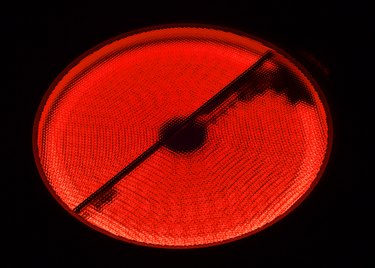
Infrared heat is the type of electromagnetic radiation used in microwave ovens. Because infrared heat penetrates and agitates food molecules instead of heating the surrounding area, food cooks very quickly. This feature gave microwave ovens vast popularity particularly in North America. However, infrared heat can alter food components that can have adverse effects on human health and safety.
Oxidized Milk Cholesterol
Video of the Day
All animal and human milk contains fatty acids and native or natural cholesterol -- not oxidized cholesterol, which increases heart disease risk. Heating milk by boiling, pasteurizing or applying infrared heat through a microwave oven changes the fatty acid and cholesterol composition of milk. A study published in a 2005 issue of the "Pakistan Journal of Nutrition" reported that infrared heat-treated, or microwaved milk contains the highest levels of cholesterol oxidation products compared to boiled or pasteurized milk. One of these byproducts is 7-ketocholesterol, a known toxic carcinogen found in human arterial plaques.
Video of the Day
Vitamin B12 Degradation
Food products of animal origin such as meats and dairy products are excellent sources of vitamin B12. Infrared heat destroys vitamin B12. A study published in a 1998 issue of the "Journal of Agricultural and Food Chemistry" reports that infrared heat or microwave heating causes vitamin B12 loss. To determine the effect of infrared heat on vitamin B12 degradation, the researchers heated raw beef, pork and milk in a microwave oven, and found vitamin B12 losses of 30 to 40 percent. In addition, the vitamin B12 derivatives formed were biologically inactive, because they failed to support the growth of a vitamin B12-dependent microorganism.
Loss of Glucosinolate
Glucosinolate is an anticarcinogenic plant substance found in vegetables belonging to the cabbage family, which includes broccoli. Research published in a 2009 issue of the "Journal of Zhejiang University Science " found that cooking broccoli in a microwave results in the highest glucosinolate loss: 60 percent -- compared with 55 percent, 54 percent, and 41 percent, respectively, in stir-fried, stir-fried and boiled and boiled broccoli.
Bacterial Infection
Bacteria thrive in temperate, hot and cold environments. Infrared heat from microwaves has been commonly used to cook and reheat foods of animal origin such as meats, seafood, eggs and poultry that may harbor bacteria which may survive the cooking process, increasing the risk of food-borne illness.
Tips and Precautions
To minimize the risk of food-borne illness, do not cook whole meats such as roasts and poultry in the microwave because it produces uneven infrared heat. Heat leftover foods to 165 degrees Farenheit or 74 degrees Celcius. Cook food thoroughly. If possible, heat milk on a stove-top burner rather than the microwave to prevent transformation of cholesterol and fatty acids. Cook or re-heat vegetables by steaming on top of the stove rather than the microwave, since steaming vegetables results in the lowest nutrient losses.
- "Pakistan Journal of Nutrition"; Influence of Microwaving and Conventional Heating of Milk on Cholesterol Content and Cholesterol Oxide Formation; Saquer M. Herzallah; 2005
- "Federation of European Biochemical Societies"; 7-ketocholesterol-Induced Apoptosis. Involvment of Several Apoptotic but Also Anti-Apoptotic Calcium-Dependent Transduction Pathways; A. Berthier; et al.; June 2005
- "Journal of Agricultural and Food Chemistry"; Effects of Microwave Heating on the Loss of Vitamin B12 in Foods; Fumio Watanabe; et al.; February 1998
- "Journal of Zhejiang University Science"; Effects of Different Cooking Methods on Health Promoting Compounds of Broccoli; Gao-Feng Yuan; et al.; August 2009
- Health Canada: Microwave Ovens and Food Safety; August 2010
- U.S. Environmental Protection Agency: Microwave Ovens; July 2010